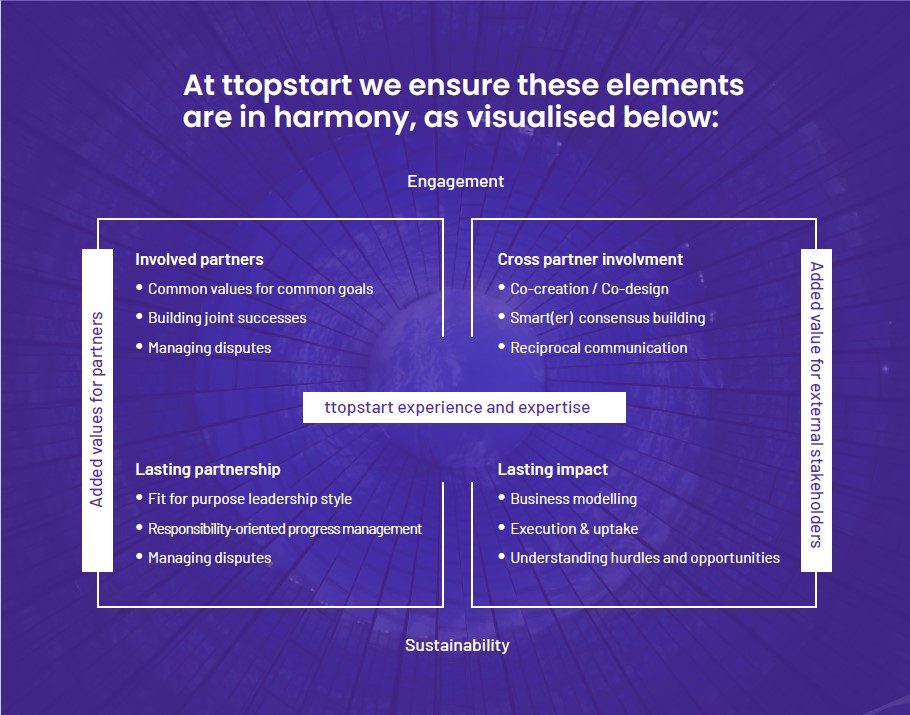At ttopstart we support consortium partners beyond the grant agreement. Our work is based on co-creation and life-cycle thinking.
This means that we work towards sustainable project outcomes and making true impact. In this, and the following 3 Project Management articles, we go more in-depth with the 4 key elements we have identified for successful consortium management; involved partners, cross-stakeholder involvement, lasting partnerships and lasting impact. In this article, we will focus on involved partners.

ttopstart’s project management approach
At ttopstart, we have developed a framework for complex multi-partner projects with partners from different backgrounds (such as public-private partnerships with academia, industry, SMEs, patient organizations, etc.). It ensures that all partners collaborate based on common values and stay aligned on different levels during the project. We know that engagement and involvement is not just about cooperating with the partners you already know, performing tasks in parallel of each other, or just adding partners for no particular role. Engagement is searching for and identifying the expertise and competences that bring added value to the consortium.
Successful projects require involved partners
At ttopstart, we have ample experience with large, high impact projects and multi-national/multi-cultural consortia. We understand the components of a smoothly running project, which takes more than simply reporting to the funding agency and providing logistical support.
We believe that it is essential, to not only have the general project management support, but go beyond and emphasise engagement and sustainability. Because, if a consortium is dysfunctional in its performance, the results will be suboptimal. In our market research we have performed investigations on what makes a research project successful. We have identified the main hurdles for a consortium to function optimal, which often concerns the soft skills within the consortium. More specifically, the results showed that having a collective goal within the consortium, is a crucial factor for success. By far, the most harmful factor is if the consortium partners are not engaged.
3 important steps to successful partner involvement:
1. Managing disputes
- This is the basic layer for the creation of engaged and involved partners. As an independent partner in the consortium, we can compile the facts and the evidence. As ttopstart we can keep our objectivity because there is no stake in it for us, besides to see the consortium work as best as possible. Because of our experience, we can co-create creative solutions and take part of active communication. We will facilitate decision making and implement a win-win scenario.
2. Building on joint successes
- In a consortium 1+1 = 3. You build on knowledge and results you couldn’t have done separately. This is what we focus on at ttopstart. To make sure the cooperation is optimal to use each other’s knowledge to create the next step.
3. Common values for common goals
- The ultimate result in involving partners is to be fully aligned with your values to go for a common goal. Here, the maximal results are gained, because all efforts and skills are aligned to reach maximum impact with the results.
Working in multinational and multi-cultural projects can be challenging. Involving your partners and truly making them share that common goal is key for creating large impact. At ttopstart we fully support the consortium in achieving this.
Watch our video on the added value of involved partners